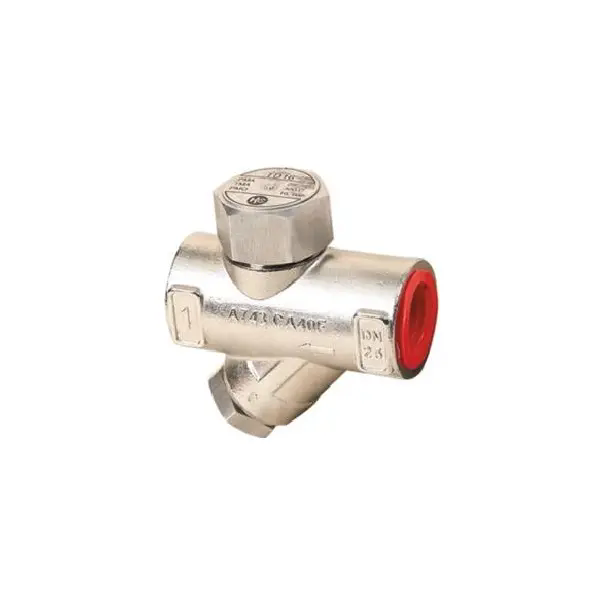What Makes Steam Traps the Key to Efficient and Sustainable Industrial Systems?
2025-11-05
Steam traps are indispensable components in steam systems, ensuring that steam energy is used efficiently without loss or waste. These devices automatically discharge condensate, air, and other non-condensable gases from steam pipelines while preventing live steam from escaping. By doing so, steam traps maintain system efficiency, protect equipment from corrosion, and optimize energy usage across industrial operations.
In industrial facilities such as refineries, food processing plants, chemical factories, and power generation units, steam traps play a critical role in maintaining stable operation. Without them, accumulated condensate can cause water hammer, reduce heating efficiency, and lead to severe damage in high-pressure systems.
The goal of this article is to explore what steam traps are, why they are vital to modern industries, how they function, and what future trends are shaping their development. It also provides a detailed look at product specifications and practical FAQs to help decision-makers select the right solution for their system needs.
How Do Steam Traps Work and What Are Their Core Features?
Steam traps function as automatic valves that distinguish between steam and condensate. Their operation depends on physical principles—such as temperature, density, and phase difference—to open or close at precise moments, ensuring the discharge of condensate without steam loss.
There are three main types of steam traps, each suitable for different applications:
-
Mechanical (Float and Thermostatic) Steam Traps – Operate using buoyancy. The float rises with condensate level, opening a valve to discharge it. Ideal for systems with continuous condensate flow.
-
Thermodynamic Steam Traps – Rely on the difference in dynamic pressure between steam and condensate. Compact, durable, and suitable for high-pressure systems.
-
Thermostatic Steam Traps – Work based on temperature differences. They automatically adjust according to the temperature of condensate and steam, providing precise discharge control.
Technical Specifications Overview
| Parameter | Description |
|---|---|
| Operating Pressure Range | 0.1 MPa – 4.5 MPa |
| Operating Temperature | Up to 425°C |
| Discharge Capacity | 50 – 20,000 kg/h (depending on model) |
| Body Material | Carbon Steel, Stainless Steel, or Alloy Steel |
| End Connection Type | Screwed, Flanged, or Socket Weld |
| Applicable Medium | Saturated Steam, Superheated Steam |
| Maximum Differential Pressure | 4.5 MPa |
| Maintenance Interval | Every 6–12 months recommended |
| Standard Compliance | ISO 9001, ASME, EN Standards |
Each specification directly influences system efficiency and safety. For example, using stainless steel models in corrosive environments significantly extends service life, while selecting traps with suitable pressure ratings ensures stable operation under fluctuating loads.
Why Are Steam Traps Crucial for Energy Efficiency and Sustainability?
The importance of steam traps extends beyond system performance—they are central to energy conservation and sustainability strategies. Inefficient or faulty steam traps can cause substantial energy loss, leading to higher operational costs and unnecessary carbon emissions. According to industry studies, up to 20% of total steam produced can be wasted through leaking or malfunctioning traps if not properly maintained.
Energy and Cost Benefits of Well-Functioning Steam Traps:
-
Enhanced Thermal Efficiency – Proper condensate removal ensures heat exchangers and process equipment operate at maximum efficiency.
-
Reduced Steam Loss – By preventing live steam from escaping, steam traps save significant amounts of energy over time.
-
Equipment Longevity – Regular condensate removal prevents water hammer, rusting, and pitting in pipelines and valves.
-
Lower CO₂ Emissions – Efficient energy use translates into reduced fossil fuel consumption and a smaller carbon footprint.
-
Operational Safety – Eliminating condensate build-up minimizes the risk of mechanical failure and thermal shock.
Many industries are now integrating smart monitoring systems into steam traps. These systems use sensors and IoT technology to detect leaks, temperature fluctuations, and trap failures in real time. Predictive maintenance, powered by data analytics, helps operators replace or repair traps before performance drops, further optimizing energy use.
In a world moving toward carbon neutrality, steam traps represent a small but powerful part of the sustainability puzzle. By maintaining optimal system efficiency, they align with green manufacturing initiatives and environmental compliance standards.
How Are Steam Traps Evolving for the Future?
The future of steam traps lies in digitalization, automation, and material innovation. Modern industries demand more than mechanical reliability—they require intelligent performance monitoring and precise energy management.
Emerging Trends:
-
Smart Steam Traps with IoT Integration:
Intelligent sensors now allow real-time tracking of steam trap performance. These devices can send alerts to maintenance teams, reducing downtime and improving plant-wide energy efficiency. -
Advanced Materials for Longevity:
Manufacturers are increasingly adopting duplex stainless steel and carbon-molybdenum alloys for greater corrosion resistance and pressure tolerance. -
Compact and Modular Designs:
New trap designs offer compact footprints and easy installation, making them ideal for retrofitting older plants or space-limited facilities. -
Predictive Maintenance Systems:
AI-driven analytics predict when a steam trap will fail based on flow rate, vibration, and temperature data—minimizing unplanned outages. -
Sustainability Compliance:
As industries move toward ISO 14001 certification and carbon reduction goals, energy-efficient steam traps help meet regulatory standards and corporate sustainability targets.
With global energy costs rising and governments promoting low-carbon operations, steam traps are poised to become smarter, more efficient, and more environmentally friendly.
Common FAQs About Steam Traps
Q1: How often should steam traps be inspected or maintained?
A1: Steam traps should be inspected at least every six months. The frequency depends on operating conditions, steam quality, and system design. Plants with high-pressure systems or continuous operation should consider quarterly checks. Using ultrasonic or thermal monitoring devices can simplify this process and detect leaks early.
Q2: What happens if a steam trap fails in the open or closed position?
A2: If a steam trap fails open, it allows live steam to escape, causing significant energy loss. If it fails closed, condensate accumulates in the line, leading to water hammer and reduced heating efficiency. Both conditions increase operational risks, making timely maintenance essential.
What Role Does Taian Play in Delivering High-Quality Steam Traps?
Taian has established itself as a trusted manufacturer of precision-engineered steam traps, designed for durability, efficiency, and adaptability. With a focus on technological innovation and sustainable design, Taian’s product line supports industries ranging from petrochemical and textile to food processing and pharmaceuticals.
Each Taian steam trap is crafted under strict quality control systems and tested for pressure resistance, leak prevention, and discharge accuracy. The company’s engineering team continually develops new designs that align with global energy efficiency standards and smart factory requirements.
In addition, Taian offers customized solutions tailored to specific operational conditions—ensuring that clients achieve optimal condensate management with minimal maintenance demands. By integrating traditional engineering expertise with digital monitoring systems, Taian ensures reliable performance and long service life in even the most demanding environments.
As industries worldwide move toward smarter, greener, and more efficient operations, Taian continues to provide solutions that embody reliability and innovation.
For more information about steam traps, technical specifications, or tailored solutions, contact us today. Our team of experts is ready to assist with system optimization, product selection, and energy-saving consultation to help your operations achieve maximum efficiency and sustainability.



